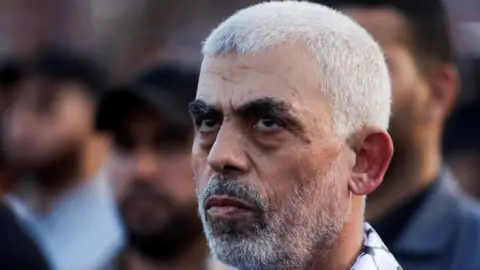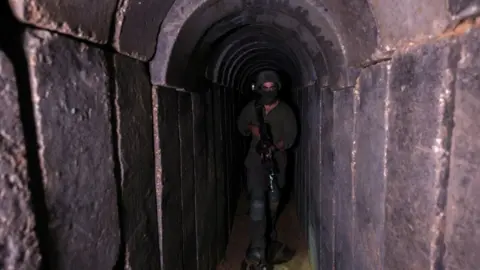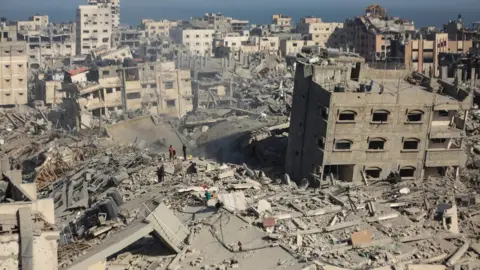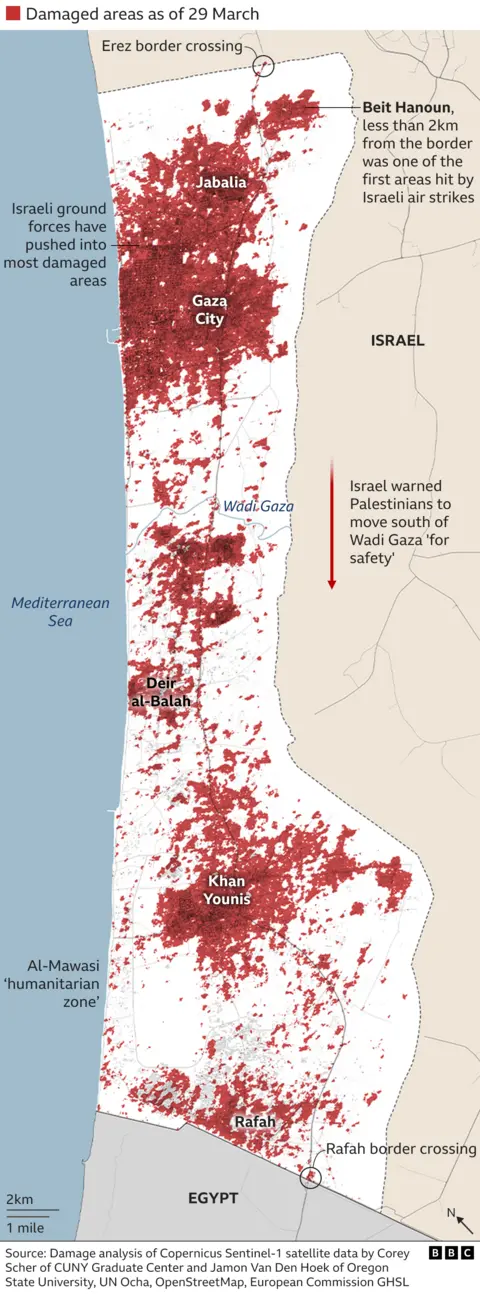Merlyn Thomas & Jake Horton

It has been nearly six months since Hamas fighters broke through from Gaza into Israel on 7 October, killing about 1,200 people and taking hundreds hostage.
In response, Israel vowed to "crush and destroy Hamas" so that it no longer posed any threat, and to bring all the hostages home.
In the brutal war that has followed, at least 33,000 Palestinians have been killed, according to the Hamas-run health ministry, and large parts of Gaza have been destroyed.
Israel says it has killed thousands of Hamas fighters and destroyed much of the vast network of tunnels beneath Gaza, which Hamas has used to carry out attacks.
BBC Verify has combed through public statements and social media posts by the Israel Defense Forces (IDF) and assessed the evidence behind Israel's stated aims.
How many Hamas leaders have been killed?
Before 7 October, Hamas was thought to have about 30,000 fighters in Gaza, according to reports quoting IDF commanders.
Many of Hamas's senior political figures such as Ismail Haniyeh, widely considered to be the group's overall leader, live abroad. But many of its military leadership structure are thought to be inside Gaza.
In a recent statement, the IDF said it had killed about 13,000 Hamas fighters since the start of the war, although it did not say how it calculated that figure.
Israel also publishes the names of individual Hamas leaders it says have been killed.
A total of 113 people have been named in this way since October, the overwhelming majority of whom were reported killed in the first three months of the war. By comparison, the Israeli army did not report any senior Hamas leaders killed in Gaza this year until March.
On 26 March, the IDF said it had killed Marwan Issa, deputy commander of Hamas's military wing. Considered one of Israel's most-wanted men, he would be the group's most senior leader to be killed since the war began. The US has said it believes he was killed, but Hamas has not confirmed it.
The IDF publishes names of individuals who it says are senior Hamas leaders who have been killed, but it is not possible to verify whether they are members of the group. One of those named in this category was Mustafa Thuraya, who was working as a freelance journalist in southern Gaza when his vehicle was hit in January.
We also found duplicate names in the list, which we have discounted from the total.
Outside Gaza, Hamas political leader Saleh al-Arouri died in an explosion in Beirut's southern suburb of Dahiyeh in January. Israel is widely considered responsible for that attack.
However, experts we spoke to said many of the group's prominent leaders in Gaza, including Yahya Sinwar, are still believed to be alive.
 ReutersMany of the group's prominent leaders in Gaza, including Yahya Sinwar, are believed to still be alive
ReutersMany of the group's prominent leaders in Gaza, including Yahya Sinwar, are believed to still be alive"The IDF hasn't been able to get to the top brass of the Hamas leadership," says Mairav Zonszein, a senior analyst on Israeli-Palestinian affairs at the International Crisis Group.
"Both on a symbolic level of getting to the main leaders, and also on the level of replacing Hamas as the holder of the territory, that's something that it hasn't been able to achieve," Ms Zonszein says.
How many hostages remain in Gaza?
According to Israeli official figures, 253 people were taken hostage on 7 October. Of these:109 have been released as part of prisoner exchanges or in separate deals
3 have been rescued directly by the Israeli army in military operationsThe bodies of 12 hostages have been recovered, including three that the IDF admitted to killing in one of their operations
The youngest confirmed living hostage is 18 and the oldest aged 85.
Of the remaining 129 hostages, Israel says at least 34 are dead.
Hamas says the number of dead hostages is higher - the result of IDF air strikes. But it is not possible to verify these allegations.
The two youngest hostages taken in the Hamas attacks were Ariel and Kfir, who were 4 years and 9 months old respectively at the time of their abduction. Their deaths have been reported, but not confirmed.
 ReutersFernando Simon Marman and Louis Hare were released in February
ReutersFernando Simon Marman and Louis Hare were released in FebruaryHow much of the Hamas tunnel network has been destroyed?
As part of its pledge to eliminate Hamas, Israel promised to destroy the group's extensive tunnel network beneath Gaza, which it uses to move goods and people.
"Think of the Gaza Strip as one layer for civilians and then another layer for Hamas. We are trying to get to that second layer that Hamas has built," IDF spokesperson Jonathan Conricus said in October.
Hamas has previously said that its tunnel network stretches for 500km (311 miles), although there is no way to independently verify this.
 ReutersHamas has said its tunnels stretch for 500km, although it's not possible to verify this
ReutersHamas has said its tunnels stretch for 500km, although it's not possible to verify thisWe asked the IDF how many tunnels, and what proportion of the total tunnel network, they had destroyed. In their reply, they said their forces had "destroyed a great deal of the terrorist infrastructure in Gaza".
The IDF has occasionally shown evidence of Hamas tunnels they've uncovered. For example, in November, the IDF released video footage of part of a tunnel network underneath the al-Shifa hospital in Gaza City which it said was being used as a command centre.
To try to determine the extent of the overall network uncovered by the Israeli forces, BBC Verify has reviewed all the IDF messages on the social media platform Telegram referencing tunnels in Gaza, between 7 October 2023 and 26 March 2024.
Of these, 198 mentioned the discovery of tunnels, where the army said it had located tunnels or tunnel shafts. Another 141 messages claim that a tunnel has been destroyed or dismantled.
Most of those did not give precise details or specific locations, so it is not possible to corroborate the extent of the network the IDF has uncovered or destroyed.
The labyrinth beneath Gaza is made up of several components, including tunnel routes and rooms of various sizes, as well as the point at which the tunnel meets the surface - these are known as tunnel shafts.
 ReutersNearly six months since the war began, much of Gaza has been left in ruins
ReutersNearly six months since the war began, much of Gaza has been left in ruinsOf the messages we analysed, 36 referenced striking a total of more than 400 tunnel shafts. However, equating a shaft with an entire tunnel would be misleading, says Dr Daphné Richemond-Barak, an expert on underground warfare who teaches at Reichman University in Israel.
The simple destruction of tunnel shafts leaves the network intact, she says. "I don't think we've seen a lot of full destruction of tunnels in this war," she adds.
Israel's offensive has come at a high price
Israel's war aims have come at an immense cost to Palestinians in Gaza. More than 33,000 people have been killed, according to the Hamas-run health ministry.
The ministry's latest demographic breakdown from 5 April indicates more than 70% of those killed were women and children.

Many others have been displaced and left homeless as Israeli forces attempt to destroy Hamas infrastructure. Over 1.7 million people have been internally displaced, according to the United Nations.
Residential areas have been left ruined, bustling streets reduced to rubble, universities destroyed and farmlands churned up.

More than 56% of Gaza's buildings have been damaged or destroyed since 7 October, according to satellite data analysis.
Six months since the war began, it is still unclear whether Israel has met its aims in the war.
Additional reporting by Rob England, Maryam Ahmed, Jamie Ryan and Emma Pengelly.
No comments:
Post a Comment